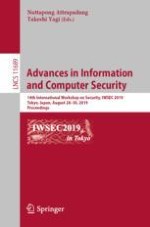2019 | Buch
Advances in Information and Computer Security
14th International Workshop on Security, IWSEC 2019, Tokyo, Japan, August 28–30, 2019, Proceedings
herausgegeben von: Nuttapong Attrapadung, Takeshi Yagi
Verlag: Springer International Publishing
Buchreihe : Lecture Notes in Computer Science






